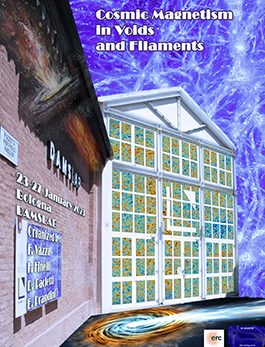Speaker
Description
Post-reionization neutral hydrogen (HI) intensity mapping (IM) offers an efficient technique for mapping large-scale structures in the universe. We apply the Tapered Gridded Estimator (TGE) on a 24.4 MHz bandwidth uGMRT Band 3 data aiming HI IM at z=2.28. TGE allows us to taper the sky response, suppressing the wide-angle foreground contributions. Applying TGE, we estimate the multi-frequency angular power spectrum $C_{\ell}(\Delta\nu)$ from which we determine the cylindrical power spectrum $P(k_{\perp},k_{\parallel})$. This method naturally overcomes the issue of missing frequency channels. We introduce the Cross TGE, which cross-correlates two cross-polarizations (RR and LL) to estimate $C_{\ell}(\Delta\nu)$. The Cross TGE is expected to mitigate several effects like noise bias, calibration errors etc., which affect the `Total' TGE, which combines the two polarizations. The measured Cross $C_{\ell}(\Delta\nu)$ is modelled to yield maximum likelihood estimates of the foregrounds and the spherical power spectrum $P(k)$ in several $k$ bins. Considering the mean squared brightness temperature fluctuations, we report a $2\sigma$ upper limit $\Delta_{UL}^{2}(k) \le (58.67)^{2}$ $\rm{mK}^{2}$ at $k=0.804$ $\rm {Mpc}^{-1}$ which is $5.2$ times tighter than our previous estimate with the Total TGE. Assuming that the HI traces the underlying matter distribution, we have estimated $[\Omega_{HI} b_{HI}]$ where $\Omega_{HI}$ and $b_{HI}$ are the HI density and linear bias parameters respectively. We obtain a $2\sigma$ upper limit $[\Omega_{HI}b_{HI}]_{UL} \leq 0.061$ from this approach. Using their contrasting decorrelation properties, we also use a foreground removal technique to distinguish the foregrounds and the $21$-cm signal from the $C_{\ell}(\Delta\nu)$. We found $[\Omega_{HI} b_{HI}]_{UL} \leq 2.17 \times 10^{-2}$ which is although $\sim10$ times larger than the expected value, nonetheless, $\sim3$ times improved over the foreground avoidance approaches.

